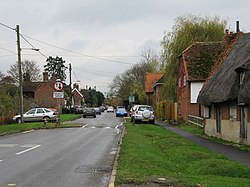Long Wittenham
| Long Wittenham | |
| Berkshire | |
|---|---|
 Long Wittenham | |
| Location | |
| Grid reference: | SU5493 |
| Location: | 51°38’13"N, 1°12’40"W |
| Data | |
| Population: | 950 (2001) |
| Post town: | Abingdon |
| Postcode: | OX14 |
| Dialling code: | 01865 |
| Local Government | |
| Council: | South Oxfordshire |
| Parliamentary constituency: |
Wantage |
| Website: | Long Wittenham village website |
Long Wittenham is a village in northern Berkshire found three miles north of Didcot, and 3½ miles south-east of Abingdon, in the Ock Hundred.
The village was formerly be known as Earl's Wittenham, after its owner Gilbert de Clare, the Earl of Gloucester[1].
Long Wittenham lies by a loop in the River Thames, on slightly higher ground than the flood-plain around it. About a mile to the east, across the river in Oxfordshire, was the Roman town of ‘’Dorcic’’, now Dorchester on Thames. To the south-east lies neighbouring Little Wittenham and the Wittenham Clumps, otherwise called the Sinodun Hills.
The village
The village has an annual fete, which is widely attended. It used to take place at the Vicarage until the mid 1990s, whence it was re-located to The Plough Inn.
At the eastern edge of the village lies the Neptune Wood, planted in planted 2005 as one of the 33 British Trafalgar Woods[2], planted to commemorate the 200th anniversary of the Battle of Trafalgar.
The village has a sporting club: Long Wittenham Athletics Club, which is based at Bodkins Field. This and other flat fields around the village have often been used as impromptu landing sites for hot-air balloonists.
History
The village is supposedly named after an otherwise unknown Saxon chieftain, named Witta, though many ages have left their mark in the soil: Bronze Age double ditch enclosures and middle Bronze Age pottery were identified in the 1960s[3], and early Bronze Age items, such as an axe and spearhead, have been found in the Thames here,[4] while Iron Age and Roman presence is shown by trackways, enclosures, farms and villas, burials, pottery and coins[5].
The village itself began in the early Saxon period. 6th Century cropmarks outline a large collection of buildings, which indicate a high status Saxon enclosure, and the variety and number of objects wre found in Saxon burial sites around the village. Large Saxon burial sites also indicate a good sized population that lasted over many years. Historians now recognise that the general area of the upper Thames hereabouts was the heartland of the Gewisse who created the Kingom of Wessex, though the local notion that the otherwise unknown Witta was related to the later kingly families of Wessex is unproven.
Long Wittenham is mentioned in the Domesday Book, and whilst still a rural settlement is nowadays less of an agricultural community. By Tudor times, parish records show it had a population of around 200, with arable crops: wheat, oats, barley, even rye being farmed.
In 1534, the Manor was bought Sir Thomas White and given to his foundation, St John's College in Oxford. Until recently, the President and scholars of St John's owned most of the houses in the village and much of the land. Before the Enclosure Acts there were just two large, open fields, divided into strips, which were leased to the various villagers by the College.
Local legend claims that Oliver Cromwell addressed the villagers on his way to his niece's wedding, in neighbouring Little Wittenham.
In 1857, using a special government grant for agricultural communities, the village school was built.
Buildings

The village Cross was built in Anglo-Saxon times: the base dating from the 7th century. Saint Birinus preached here when he brought Christianity to the area. The parish church of St Mary, begun around 1120, is on the site of a previous Anglo-Saxon church. The chancel arch survives from the Norman building; the aisles and tower are later additions. The font is a rare Norman lead one; at some later point it was encased in wood, and this preserved it from iconoclastic Roundhead soldiers in the 17th century[6]. The church has the smallest monument in England[7] a small stone effigy of Gilbert de Clare. Cruck Cottage can be architecturally dated to being around 800 years old and consequently locals have claimed it may be the oldest house in the area.
The building housing Pendon Museum, began as The Three Poplars public house. Declining trade forced its sale in 1954. It became a Youth Hostel, before the owner Roye England turned it into a model railway museum. Other pubs included The Machine Man (closed in 2003), The Plough and The Vine. North of the village is the Barley Mow Inn (nowadays just a pub), which is closer to Clifton Hampden but is on the Wittenham side of the parish boundary.
A Methodist chapel was built in 1820, and later converted into a butcher's, a general store, and a Post Office. It was closed in 2006 and turned into a private house.
Outside links
| ("Wikimedia Commons" has material about Long Wittenham) |
- Berkshire History: Long Wittenham including a ghost story
- Long Wittenham Church of England Primary School
- Long Wittenham Athletic Club/Football Club
References
- ↑ "www.longwittenham.com/history.html"
- ↑ "Neptune Wood". Tree for All. http://www.treeforall.org.uk/trafalgar/TrafalgarWoods/Otherwoods/Neptune/.
- ↑ "Excavations at Northfield Farm, Long Wittenham, Berks." Margaret Gray, p 107-109
- ↑ National Monuments Record Number SU59 SW 22
- ↑ "Prehistoric and Romano-British landscapes at Little Wittenham and Long Wittenham" Steve Baker
- ↑ "www.berkshirehistory.com/villages/longwittenham.html" David Nash Ford
- ↑ "www.berkshirehistory.com/villages/longwittenham.html" David Nash Ford
Further reading
- Page, W.H.; Ditchfield, P.H., eds (1924). A History of the County of Berkshire, Volume 4. Victoria County History. pp. 384–390.
- Pevsner, Nikolaus (1966). Berkshire. The Buildings of England. Harmondsworth: Penguin Books. pp. 170–171.
